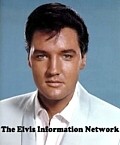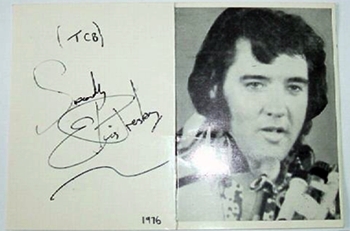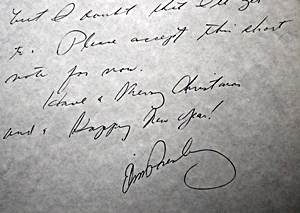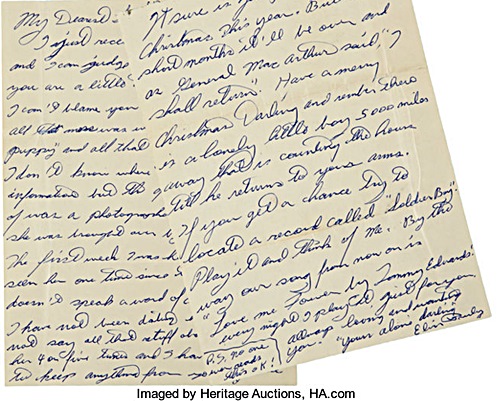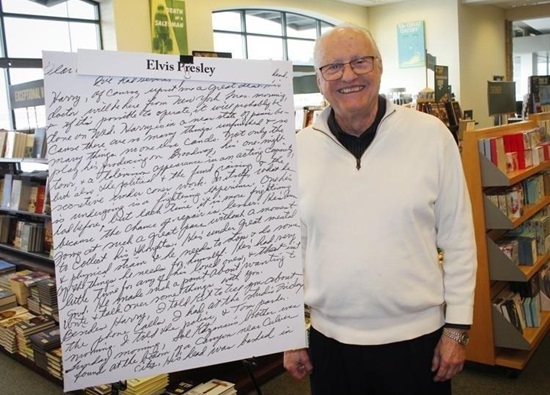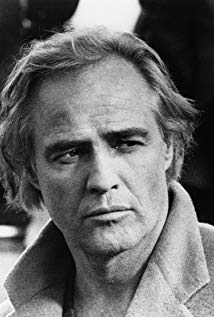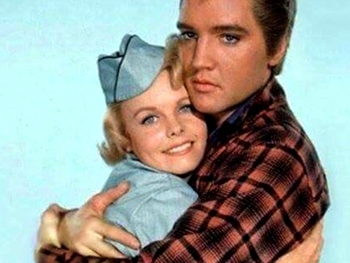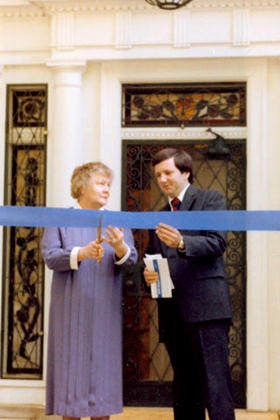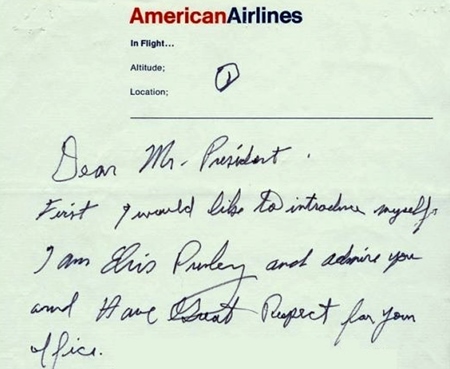 |
 |

Introduction Here we go again...... Dolly Parton's hit song from 1977 is most appropriate in considering Gary Lindberg's new book, Letters from Elvis. My comment is not meant in a disparaging way, only that it symbolises a recurring aspect of the eclectic nature of the Elvis world where periodically an allegedly Strange But True Elvis story comes along to infuriate some, and tantalise others. And more than 40 years after his death, a small part of the complex, multi-faceted Elvis world still loves a good conspiracy tale.......as attested to by the ongoing fascination some people have with intriguing ideas such as:
In his well written and at times intriguing book, Letters From Elvis, Gary Lindberg will appeal to that part of the Elvis world with claims that Elvis hand wrote and sent 65 letters from 1966/7 to 1972 to his (previously unknown) "spiritual advisor", Carmen Montez (for the record: now deceased). And it's not just Elvis who wrote to Ms Montez, but also Tom Jones, Harry Belafonte and Elvis’ other very good friend, Marlon Brando! Brando, for instance, apparently wrote around 100 letters to Ms Montez, including a number through his "spirit guides" (Brando apparently suffered from dissociative personality disorder, i.e. he had multiple personalities) - however the book is principally about Elvis.......my suspicious mind wonders why - the quite understandable and obvious answer appears below. About the author Gary Lindberg is a writer and film producer/director (That Was Then This Is Now starring Emilio Estevez and Morgan Freeman), who has won over 100 major national and international awards. Lindberg operates a publishing company, Calumet Editions, and has written a number of books of historical and supernatural fiction. He also has a background in Graphology/Graphoanalysis, having written the non-fiction book, The Power of Positive Handwriting, with his mother, Elayne V. Lindberg. EIN note: That Lindberg has released several books of historical fiction does not mean he is a modern day L. Ron Hubbard, who morphed his writing of science fiction novels into Dianetics (the foundation of Scientology)! While others make issue with Lindberg using his own publishing company to release Letters from Elvis (major publishers wouldn't touch the book), I do not share their concern. Calumet Editions has been established for some time and published many books by many different authors. In any case, in Letters from Elvis Lindberg discusses, in some detail, the issues he confronted over three decades before finally getting the book into print. In relation to publisher rejections (prior to him establishing Calumet Editions), he records: Simon & Schuster wrote that the claims:
However, Random House raised the spectre of EPE and its comments lend validity to Lindberg's claim around the legal issues of copyright, privacy, etc:
I don't know Gary Lindberg, but from what I've read about him in interviews and through his measured presence (in the face of considerable criticism) on the FECC board, he seems like a reasonable person: Lindberg posted this comment on the FECC board:
I did find the following quote (which others have also drawn attention to) from his website, Gary Lindberg Beyond Belief, interesting:
It may be just my over-active, suspicious mind (again), but the foregoing quote combined with the following description of one of his books is intriguing:
Is it, that after his pursuit over several decades in bringing Letters from Elvis to the public, Lindberg has fallen victim to that which he is interested in?
How the letters came to light Allegedly, around 1966-67, Harry Belafonte facilitated communication between Elvis and Carmen Montez. Elvis then corresponded with her through the writing of the 65 letters. She later formed a close friendship with another Carmen, Carmen Rayburn (deceased). When Ms Montez died intestate in 1982, her assets were put up for auction and Ms Rayburn bought three trunks of her possessions, one trunk containing the cache of letters. Of particular interest in Letters from Elvis is a copy of a typed and hand signed letter dated September, 2, 1966 from Harry Belafonte to Ms Montez. Its content is Belafonte agreeing to invest $10,000 in a film, Then There Was Light, for which he was being considered for the part of Euriah. If this letter is genuine it does establish Belafonte at least knew Ms Montez. A check of IMDB does not reveal a film with that title nor does it have a listing for Ms Montez or Joi Sommers (who apparently wrote the film script). Deconstructing Letters From Elvis - what is the truth? One only needs to critically consider a few of the brave (or foolish?) assertions made in Lindberg's book to discover its lack of credibility: Who is Carmen Montez (deceased)? The name Carmen Montez appears in none of the major Elvis biographies and that places her in the same "Twilight Zone" realm as Elvis’ alleged long-time lover and mother of Desiree Presley, Lucy de Barbin (author of the very readable, but equally unbelievable book, Are You Lonesome Tonight? (1987). As none of Elvis' family or members of the Memphis Mafia have ever mentioned Ms Montez, EIN recently asked Larry Geller (Elvis’ widely known "spiritual advisor") about Elvis' other "spiritual advisor" - Larry said Elvis had never mentioned Ms Montez. Lindberg indicates Elvis deliberately kept her away from his circle of friends. Another "red flag" is that Elvis and Ms Montez never actually physically met and underpins why Elvis would write 65 letters to someone he hadn't met with the claim that Ms Montez came to Elvis in "out of body" visits. The lack of physically meeting is reminiscent of the sad and incredulous case of psychiatrist, Dr Donald Hinton, who was found guilty of both mail fraud and prescribing medication to a man he had never met - namely "Jesse", but who he believed to be a still alive Elvis Presley. Hinton served five years probation and had his right to prescribe medication revoked by the Missouri State Board of Healing Arts. In 2001, Hinton published his book (written with "Jesse") The Truth About Elvis Aron Presley In His Own Words. In the interests of fairness and providing all sides of the argument, the Hinton case did take an unusual turn, and one which is relevant to Letters from Elvis. I will let you be the judge of what this excerpt from ProbateLawyerBlog means, simply noting that it is very strange a graphologist and not a "forensic" handwriting analyst was engaged (I talk more about graphology/graphoanalysis later in my review): But the Dr. Hinton investigation did lead to an interesting place. When Dr. Hinton came under attack, his patient, Jesse, wrote a letter to the Attorney General supporting Dr. Hinton and refuting the mail fraud claims. He included the following in his letter:
The vast majority of Elvis autographs up for sale are fakes, with probably less than 5% being genuine - and when Elvis was alive Graceland employed secretaries who would often fake his signature and personal messages on letters.
The handwriting analysis (forensic document examination/questioned documents examiner - graphoanalysis - authentication and anti-exclusion bias)
Lindberg bases much of his case on the handwriting analysis of six (6) photocopied letters and two (2) holograph (handwritten by the signee) letters allegedly from Elvis to Ms Montez. They were assessed by world renowned handwriting (FDE) expert, Charles W. Sachs, most notable for providing key testimony that led to the finding an alleged will by Howard Hughes was fake.
For the record, in his letter dated 19 November 1988 about his analysis, Sachs states:
It is important to note that in Mr Sachs assessing photocopies of six "Elvis" letters an important element of handwriting analysis, namely pen pressure (which varies from one writer to another), would not have been possible to assess. The two holographic letters would have been the only “Elvis” documents allowing a full analysis against exemplers to be undertaken. This is normally too small a sample for proper evaluation. Had all eight samples been holographic in nature they would have constituted a reasonable sized sample for Sachs to form his expert opinion as to whether or not the letters had been written by Elvis Presley. As Sachs evaluated the letters 30 years ago (he was active as a handwriting analyst in the 80s and 90s), it is not surprising little about him exists on the Internet, beyond his role in the Howard Hughes will case. I assume he has either retired or passed away since 1988. In any case, handwriting analysis is an imprecise art and its acceptance by courts in western society is variable and not absolute. Its lack of acceptance by courts is for various reasons, including because experts are yet to determine a reliable error rate in analysis or set standards for the comparison process. There is no standard level of factor comparison or variability that must be reached for a document to be declared a match or non-match—each individual examiner makes a determination using his or her best judgment. Accordingly, the reliability of expert testimony around handwriting analysis is generally considered to be questionable, hence the jury is still out on its usefulness and admissability. There is also the issue of "authentication bias". A number of studies suggest that handwriting identification, because of its highly subjective character, is very vulnerable to context effects such as expectation and suggestion. Also, in a similar way to a market researcher or investigative researcher using a leading question, a number of studies suggest there is an anti-exclusion bias where authorship is confidently declared when the author of the exemplars is known, but exclusions when the true author is absent being much less common (with many inconclusives or indications of "cannot be eliminated"). In other words, there appears to be a bias towards confirming that the handwriting is the same as that for the person whose hand wrote the exemplar. I note that there is an extensive discussion of Letters from Elvis on the FECC board. While I don't agree with all of Lindberg's defence arguments, he is correct in dismissing those who have discounted the displayed "Elvis" letter (see image below) based on only one or two disimilarities from Elvis' known handwriting (exemplars). Putting to one side its validity as an authenication technique, "forensic" handwriting analysis is not about the odd inconsistency in letter formation - its construct acknowledges that all of us have different/alter out handwriting strokes on any given day for a variety of reasons. A person's handwriting at any time is influenced by numerous factors including their state of mind, their health and the physical context of their writing - for example, handwriting while sitting at a desk is different to an on the spot scribble for a fan after a concert performance. A "forensic" document examiner is looking not for the odd "difference" in letter formation, but rather "common characteristics" in how a person writes and how those characteristics are missing in other writings. There are a variety of elements "forensic" document analysts consider and Lindberg addresses some of them in the discussion on FECC.
Jane Hollis, a graphoanalyst, was also consulted by Lindberg. As noted, earlier, Lindberg himself, has a keen interest in graphoanalysis having authored one book on the subject. Does the graphoanalysis add anything material to Lindberg’s case? Or is it just an interesting diversion? My issue with graphoanalysis is that graphoanalysts can make sweeping claims based on changes in a person’s handwriting (it could just be the writer is having a bad day or isn’t feeling well). Ms Hollis' interpretation of Elvis' personality or character is of interest in itself. While I understand the reasoning for its inclusion, in my opinion, it doesn't add anything material to validate the underlying thematic of the book. I did find it surprising that the the chapter on Ms Hollis' analysis is 50% bigger than the chapter on authenticating the letters.
Elvis letter to girlfriend Anita Wood - sold at auction and which has also been reproduced in books.
Copyright law and the absence of reproductions of the letters in the book (a book about personal letters without any of the letters - a novel idea......I suspect it won't catch on) None of the 265 letters (65 by Elvis) are reproduced/shown in the book except for snippets of various letters (which were analysed by "graphoanalyst" Jane Hollis). The author claims he was unable to publish copies of the letters in his book due to copyright laws. This is a valid claim, as personal letters are indeed covered by copyright law. The writer owns the copyright (on the writer’s death copyright continues to exist through their estate - in the US it continues to exist for 70 years post death.......until 2047 in Elvis' case with copyright ownership being with the Presley estate or EPE). The person who received the "physical letter" owns it, but legally cannot publicly release or reproduce its contents in their entirety. The physical letters were owned by another "Carmen", the best friend of Ms Montez, Carmen Rayburn - strange but true, Ms Rayburn would subsequently receive a marriage proposal from Ms Montez's bereaved ex-husband, George........this almost reads like a plot line from the television day time soap, Days of Our Lives.
I understand that some people have made issue that other "Elvis" letters have been publicly published in books and magazines. I don’t see this having much relevance to the Montez letters as those “Elvis” letters that have been published have either been authorised for publication or contain nothing sensational, so legal action is unlikely. It seems to me that the major cause of litigation would be by the Presley family or EPE on the grounds that the letters were not written by Elvis but are clever fakes, and that they contain material harmful (defamatory) to the Elvis name and legacy. In his chapter, Legal Quicksand, Lindberg discusses the legal issues and challenges around copyright and fair use. He notes that only pure (known) facts are permissable to be reproduced without fear of litigation. While preparing my review, two related questions crossed my mind:
Considering the one known "Elvis" letter While Lindberg is prevented from publishing or reproducing the letters it is legal for him to display them at book signings, etc. In this respect, he has held a number of book signings and I was interested in whether he had put one or more of the letters on display. The answer is yes – at least one letter was blown up in size and displayed. Given the copyright issue I found it surprising that this image (which I posted the link to on the FECC board) was allowed to be published in the Minnesota Post Bulletin newspaper:
Cynics will undoubtedly argue that displaying some letters at book signings is strategic as it limits a person's ability and time to closely examine and analyse what is on display. Regarding the pictured letter, there has been some discussion about Elvis referring to the Colonel as "Tom Parker" (fourth line from the bottom of the letter). I agree that it would be out of character for Elvis to refer to the Colonel in this way and if he did it would more likely be said with a colorful adjective predicating it. The capital "T" in "Tom" is also unusual in an "Elvis written" cursive letter. As to the handwriting while there are similarities to Elvis' handwriting (e.g. upward slope of writing on the page and varying height of upper zone letters) there are also inconsistencies. For example, Elvis rarely looped the stem of his "d" after the 1950s (and in the letter above it is consistently looped), in writing words with a double L, such as "will", Elvis tended to write the first L slightly higher than the second L and the letters "g", "y" and "t" concern me. The narrative in this letter is also stylistically different to known Elvis exemplars (for instance, compare it stylistically" with Elvis' letter to President Nixon). Clauses such as "a television appearance in an acting capacity", "chance of repair" and "He made such a point" do not sound like Elvis to me. However, my observations are based only on a cursory examination and not a proper "holistic analysis" which would necessarily include an examination of many other factors including the spacing between words (which in the image, while seeming reflective of Elvis' word spacing, could be because of exaggeration due to the image being blown up) and consideration of stroke stress. The contents of the letters It is difficult not to consider the subjects covered in "Elvis" 65 letters as being fanciful, and often confronting. There are two claims which dominate the narrative:
For the purposes of my review I will address only a few of the events/incidents (the first two being interrelated): Elvis and his good friend, Marlon Brando move boxes from one of Elvis' homes to Brando's mansion in LA and Elvis' Hillcrest residence (late August 1968): The back story to this seemingly innocent, but eventually horrific incident, was that Elvis and his entourage had left LA for Palm Springs but Elvis drove back to LA alone. Before progressing the story I need to give some Elvis biography context - the general Elvis biography records that Elvis and Brando were not friends and by all accounts met only once, briefly in early 1958, while Elvis was in Hollywood filming King Creole. Elvis' co-star, Jan Shepherd, tells the story of how she and Elvis often had lunch in the Paramount film studios cafeteria. One day Brando came in and deliberately placed his chair closely behind Elvis' so that when Elvis went to get up his chair would bump Brando's chair. This is exactly what happened and Brando also got up. They shook hands and briefly exchanged pleasantries. Elvis played it cool but when he left the cafeteria Jan Shepherd said he jumped about five feet in the air as he could not believe he had just shaken the hand of one of his idols.
Elvis was held captive and sodomised: Back to the moving of boxes, according to Elvis’ letters, it resulted in what would have been the most serious event in Elvis' life! Elvis and Marlon were allegedly confronted by members of "the Katzman Gang" and assaulted. Brando was bound and gagged and Elvis abducted and taken back to his Hillcrest home where he was viciously assaulted and sodomised. I won't go further into the specifics of the ordeal but from what we know about Elvis' personality, had this event actually happened, all hell would have broken loose afterwards (reference point: consider Elvis' reaction to Priscilla and Mike Stone - more on this below). And given Marlon Brando's known personality and temper, explosive repercussions would have been expected from him as well. In this respect, Elvis expresses concern in one of "his" letters that Brando may have been responsible for the death of Marcus, the man who tortured and raped Elvis. It is also reasonable to surmise that this type of traumatic event would take some time to physically recover from and even longer to emotionally and psychologically recover from. There is no record of Elvis being depressed or physically impaired (apart from tonsillitis) around this time. For the record, late August and September 1968 was a quiet time for Elvis. He had just finished filming Charro! and spent must of September in Palm, Springs. While, Jorgensen and Guralnick in their book, Elvis Day By Day, don't record much for early September 1968, Lee Cotten's All Shook Up Elvis Day By Day 1954-1977, states that:
Both Day By Day books state that Elvis' cousin, Bobby Smith (brother of Billy), took his life on September 13 and Elvis flew back to Memphis on September 25. On 26 September Elvis went to the Memphian theater to watch Shalako and The High Commissioner. (EIN note: we suspect some will question why Elvis didn't return to Memphis after his cousin's death). Any member of the Memphis Mafia will tell you there is no way Elvis could have disappeared for several days without alarm bells ringing. Elvis always had at least one member of his family or the Memphis Mafia with him, whether he was touring in the 1950s and 1970s, filming in the 1960s or “off duty” at his homes in Memphis, LA or holidaying in Hawaii. Elvis did not like being alone. And in 1968 Elvis was married with a baby…… Elvis' one known “escape” involved his historic and quite bizarre meeting with President Nixon at the White House in December 1970 and even that involved the presence of Sonny West and Jerry Schilling. As for Sam Katzman, he was a well-known “quickie” film producer and director, who produced Kissin Cousins' and Harum Scarum and allegedly he and Elvis had a major falling out. Lindberg states that the feud (which was also with Colonel Parker) had its genesis during the filming of Kissin' Cousins:
Little is known about Katzman's non-film life, even his one biography, Katzman Nicholson and Corman, is considered to lack depth about him. Lindberg writes that like Sinatra who was rumoured to have Mafia connections, Katzman was rumoured to to be connected to various criminal activities including narcotics and money laundering. My research uncovered no archival news reports suggesting Katzman was associated with the mob or any gangs.
Cynthia Pepper and Elvis during Kissin' Cousins
Elvis' co-star in Kissin' Cousins, Cynthia Pepper, released her entertaining memoir, Pigtails, Presley & Pepper in 2014. Not surprisingly, a significant part is devoted to Elvis and the film. She also mentions Sam Katzman (King of the Quickies) as a joker who no-one really took seriously. Regarding one incident, Ms Pepper records:
There is no hint in Ms Pepper's memoir of any friction between Elvis and Sam Katzman. Lindberg does very briefly discuss the possibility that Elvis' writings on his abduction and being sodomised were male rape fantasies due to homophobia or homosexual desire. He also suggests the possibility of the Elvis and Brando letters confirming the incident being due to the rare dilusional disorder, folie a deux. This is a psychiatric syndrome in which symptoms of a delusional belief and sometimes hallucinations are transmitted from one individual to another (resulting in a shared delusion).
Vernon and Elvis, surely father and son, grieve over the loss of Gladys
Vernon Presley's twin brother, Virgil, is Elvis' biological father: Rivalling the abduction and sodomy claim, in one of his letters Elvis states "Vernon is not my real father". We are led to believe that Virgil, like Elvis’ (Aunt) Dixie Presley, was ostracised(?) and wiped from the Presley family tree. According to the letter, Elvis says Virgil was a railroad conductor and part-time evangelist. Virgil met an unfortunate death, falling from a moving train, when Elvis was still young. That was when "twin brother" "Uncle" Vernon stepped in to help. Lindberg addresses the issue of Elvis' birth certificate including the father's name as "Vernon Presley" by indicating that typical of the time official records were full of inaccuracies. He also draws attention to Dr William Hunt's Record Book which showed Elvis' father as "V.E. Presley", the implied inference being that the "V" could stand for Virgil. Of cource V.E. Presley" would be Vernon Elvis Presley (we are in the dark as to Virgil Presley's middle name). Unless I missed it, it is not explained why Virgil was erased from the Presley family history. The evidence for Virgil Presley is based on the letters, an entry in WikiTree and a healthy dose of conjecture on the part of the author. Lindberg's diversion into a genealogical mystery around Elvis' family tree is certainly interesting (if unbelievable), as was learning that Priscilla Presley apparently has two twin-half brothers, Tim and Tom. A few questions need to be asked about the WikiTree entry for Virgil Presley. For instance:
Lindberg claims he had been searching for a verification of Virgil for many years when he found it on WikiTree. Arguably, WikiTree would be one of the first places a researcher might look - in fairness, this observation has to be qualified by saying WikiTree was established in 2008 and the Virgil Presley entry was made in 2013. Other claims: There are a number of other interesting claims and twists/interpretations on the generally accepted Elvis story and the odd perplexing issue. Some of these are: Elvis (briefly) wanting to have Mike Stone (the karate champion who had an affair with Priscilla) killed - the author contends that was not just Priscilla's affair that prompted Elvis' strong reaction to the affair, but that his finding out occurred around the same time that he was "attacked" on stage by four (over zealous) fans in Las Vegas. This incident reminded him of both the bullies who assaulted him in high school and the "Katzman gang" thugs who tortured and sodomsed him. Also playing on his mind at the time was his "lost love", Jeni Pearson, and wondering who was responsible for her death. The rattlesnake placed in Elvis' trailer during the filming of Charro! - paranormal expert, Adrian Lee, suggests the motivation for this was linked to magic and the strong tie between serpent mythology and the cycle of life, death and rebirth. The magic/paranormal concept was also suggested in that Elvis was considered to be empatic (an empath) which meant he was susceptible to spells and demons sent by practitioners of voodoo. Operation Fountain Pen - Operation Fountain Pen was an FBI operation targeting white collar crime circa 1977. Vernon and Elvis inadvertently became entangled in it when Elvis' Lockheed Jetstar airplane became part of a complicated sale/leaseback scam. Those promoting the scam were a group called "The Fraternity" and had links to the Mafia. That Elvis had to fake his death and go into witness protection because of his involvement with "The Fraternity" (read: his life was in danger) is a key tenet in the "Elvis is alive" mythology. By all accounts, while Vernon had been contacted by the FBI, Elvis wasn't aware of Operation Fountain Pen when he was alive. Carmen Montez - one month after her death a mysterious letter was sent to Ms Montez from The Florida National Bank and Trust Company in Miami. It stated that she was the beneficiary of 'two million dollars' (strangely then written as '$2,000,000,000') from a trust that had been set up by an anonymous benefactor. The letter (which is shown in the book) was signed by Janice Doe.
Observation - of course, that two or more of the writers (Elvis, Belafonte, Brando and Tom Jones) mention the same event is not necessarily confirmation that the event occurred, particularly if the letters are fake. Motive and authorship If we take the position the letters are fraudulent then what was the motive and who authored them? Obviously they have existed since at least the 1980s when Charles Sachs examined them. In the intervening time no-one appears to have obtained financial gain from them. Lindberg would be hoping to gain financially but if this is his key motivator, by all accounts he has been playing the "long game". Surely, they would hardly have been written just for fun? As to who actually wrote the letters, we may never know given the time that has passed since they first became known. But it appears someone, or some people, have gone to a lot of effort in writing 250 letters and producing a very clever and involved con! Authenticating the letters - Establishing the truth There is much background information in Letters from Elvis about the steps and methods used in verifying the authenticity of the letters. While on the surface they appear exhaustive and cogent, there are some materially fatal flaws underlying Lindberg's story (I have touched on a few elsewhere in my review). For instance, Lindberg includes material sourced from four books involving Earl Greenwood to illustrate some of his argument. Greenwood's fanciful tales were well exposed by EIN contributor and investigative journalist, the late Bill E. Burk. Unlike many other books which make sensational claims, the truth and credibility of Letters From Elvis could be tested as Tom Jones, Harry Belafonte and Priscilla Presley are still alive. Any or all could be asked for verification of Lindberg's claims. In his replies to issues raised in the FECC forum discussion, Lindbergh states that Priscilla Presley, Tom Jones and Harry Belafonte were asked for their comments on the claims in Letters from Elvis. Not surprisingly, after four months none had responded. Could any of them really be bothered to answer what are incredulous (and very dissonant) claims on their life stories? Perhaps the "Elvis" letters could be submitted for computer analysis using the FISH (Forensic Information System for Handwriting) system - assuming someone is willing to pay for the analysis. Not all 65 Elvis letters or all of the other letters would need to be analysed (as it is possible each set, or all, were written by the same hand), but it would require good exemplars (known genuine examples of the Elvis's handwriting) and still be costly. I wouldn't mind Rich Consola (who has studied Elvis' handwriting for three decades) also examining the letters. For the claims in Letters from Elvis to be true would require a radical rewriting and interpretation of the Elvis Presley story. Unless I am mistaken this would be the greatest revision of the generally accepted biography of a well known person in modern history. Overall Verdict: Elvis is one of the world’s most reported on and analysed figures of the last century. In this context, there is no logic to the alleged content of the 65 "Elvis" letters discussed in Letters from Elvis. However, I don't doubt there is a market, albeit a diminishing one, for this type of book. That it will sell copies says a lot about Donald Trump's world of "fake news" and the psychology underpinning conspiracy type theories. But, Letters From Elvis fails the basic tests of credibility and crumbles under the microscope of critical analysis. My view echoes the comments from Random House - it appears the writer or writers of the letters were fantasising, although I wouldn't say just a bit, but rather a lot. And as I speculated earlier in my review, is it, that after his pursuit over several decades of bringing Letters from Elvis to the public, Gary Lindberg has fallen victim to that which he is interested in, that strong beliefs are often indistinguishable from facts in the mind of the believer? If you enjoy sensationalised stories published in tabloids like The National Enquirer, you will likely enjoy this OTT and at times, quite offensive tale of fiction. The author (probably) did get one thing right though - he realised that money can be made by using "Elvis" as the book's hook. Marlon Brando, Tom Jones and Harry Belafonte, despite their great talent and fame, don't sell books.
|
|
